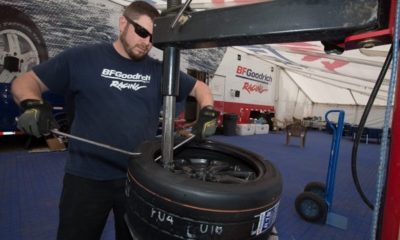Sometimes a small difference in wheel width can make a big difference in performance.
We were able to sit down with Mazda Motorsports factory driver Tom Long and Motorsports Technical Director for BFGoodrich® Tires Ken Payne to discuss the advantages of wheel width.
“The rim width affects the tire’s contact patch,” Long explains. “So when we’re playing with that, and the car acts differently and has different characteristics on a stock rim vs. a wider rim, I prefer the wider rim – to a point. Not only because it goes faster, but has better feel in braking and cornering and just overall grip and confidence.”
In choosing a tire and wheel combo for a new race car spec, such as when Tom helped to do for the Spec MX-5 and the MX-5 Cup car, fast wasn’t the only consideration – component life was a key factor to consider, along with the expense of consumables. But for many racers, fast is the primary, if not the only thing that matters. Rules matter as well, of course, so for many racers that may be the limiting factor. But where there’s some freedom to choose wheel and tire sizes, how they affect each other and work together is worth considering.
Tire manufacturers provide a darn good baseline, providing recommended rim widths for any given size tire. Sometimes rim width, but not tire width, is limited by the rules, so a racer may be tempted to see just how wide he or she can go. Eventually, increasing tire width will produce diminishing returns and start slowing you down.
“Sometimes it’s just basic geometry and sometimes it’s actual design, but any given tire is typically built to operate within a defined window of rim widths,” explains Payne. “When you design the tire, you have to pick some width you’re going to use as your starting point to optimize the shape of the profile of the tire. So you’re setting up the radii of the different curves in the sidewall, the upper shoulder and the summit, all based on a tire being applied to a given rim width. Normally that’s toward the upper range of what the recommended rim widths are for a given tire.”
The effect of going to a wider or narrower rim is a change in the shape of the tire, and the tire’s contact patch.
“Once you start changing that rim width – say a tire is designed for a nominal rim width of seven inches, and you only have five-inch-wide wheels, suddenly you’re pinching that tire down enormously. The profile of the carcass, its inflated shape, is no longer optimum. It’s sort of an inverted triangle – the wide part is on top and the sidewall slopes inward. That doesn’t give you much resistance to lateral force. The opposite is true as you go wider. A perfect rim width that exactly matches the width of the tire, you could think of it as being a perfect rectangle. As you go wider [with the rim], the bottom is going to get a little wider than the top, so again you’re going to a trapezoid shape, where you’re sloping up toward the summit, and you’re getting more resistance to lateral movement due to the orientation of the sidewall,” he says.
In general, the wider the rim, the better – “The recommended rim widths are a great starting point; if you have the opportunity to err on the high side of that range, for motorsports applications that’s probably a good place to be,” Payne says. But that’s true up to a point. As you get to a certain threshold, you begin stressing things past their designs, and can see some strange temperatures across the tire. An autocrosser may be able to get away with some things a road racer can’t, Payne adds, simply because the tire is exposed to those stresses for a shorter period of time and the temperatures aren’t as extreme.
There is also the matter of changing rim diameter. Going to a larger wheel diameter is mainly useful to expand your choices of tires. If you’re competing on a car that was originally equipped with 13- or 14-inch rims, you know the pain of finding good competition tires, which is why the rules often allow racers to go up in wheel diameter. That, of course, comes with tradeoffs, such as greater unsprung weight and more mass to get spinning under acceleration, so you probably only want to go big enough to use your desired tire.
“In terms of ultimate performance, it’s a mixed bag,” Payne says. “You have to take into consideration what you’re doing to unsprung weight. Can you match the correct offset so you have the tire in the right place on the corner in terms of suspension geometry? All those dynamics come into play so there isn’t a real clean-cut one-size-fits-all answer.”


 ACCESSIBILITY
ACCESSIBILITY